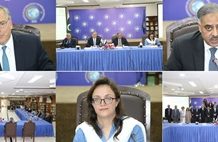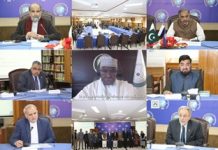The United States and its Afghan allies need to reconsider their strategy and focus more on negotiating local and regional political settlements. They also need to remain open to including the Taliban in the process of national reconciliation. Their atrocities and bloodletting was no worse than some of the warlords’ in and around power in Kabul
The twin strategy of war and reconstruction in Afghanistan has failed to achieve any remarkable success. The country is sliding fast into chaos and disorder, particularly on its southern and eastern periphery. If other areas are calm, it is not because the state has extended its writ to them, but because it has surrendered its authority to the local warlords. There is general despondency and frustration among the population.
Their grief and anger is widely shared by the international community and by friends of Afghanistan throughout the world. After three bouts of deadly war, the Afghans thought they would have a better, peaceful future and economic opportunities to reconstruct their individual and collective lives.
The Taliban have re-emerged as a formidable force, against the hope that international intervention and political reconstruction would end the war. The warlords continue to stay put and strong, forcing President Hamid Karzai to make compromises. The Pashtun regions remain unstable and out of the government’s control.
Local farmers and international drug-traffickers have found the absence of the Afghan state and weak political and security arrangements auspicious for reviving poppy cultivation on a scale never known before in the history of the country. Afghanistan unfortunately has become a narcotics state a development that has taken place in the presence of NATO, ISAF and US forces.
The situation inside Afghanistan is not very hopeful and it is likely to get worse. Those optimistic about the future of the current government or about the ability of the international coalition of forces to do better in the coming months and years are declining in number. Let us examine in detail what went wrong in Afghanistan.
First, the US strategy toward Afghanistan was shaped hurriedly in an atmosphere of anger; thus it became centred on ousting the Taliban, whose ideological make-up, ruling style and leadership had been widely demonised in the western media. The presence there of Al Qaeda and Osama bin Laden, and their operating from sanctuaries in Afghanistan made a good justification for war before the angry and highly demoralised people of the United States after the terrorist attacks of 9/11.
I believe the Taliban were misunderstood by being conceived in the image of extremist Islamic political movements. They were essentially Pashtuns in terms of ethnicity and had among their ranks all kinds of Pashtuns, not just those motivated by religion. The Pashtuns, who represent sixty percent of the population of Afghanistan, were frustrated by the way the Tajiks captured power in Kabul after the fall of its communist regime in 1992. They found themselves out of power, divided in small factions and controlled by large numbers of gun-totting warlords. The rise of the Taliban presented them an opportunity to reclaim the country from Tajik rule. Religion and nationalism are two sides of the Afghan identity, which is historically associated with the Pashtun national ethos.
The US and its Afghan informers and experts were wrong in presenting the Afghan civil war, which in fact was ethnic in orientation, structure of forces and social bases of support, merely in religious terms. With the benefit of hindsight, it now looks questionable if dislodging the Taliban from power was necessary to get Osama bin Laden and to destroy Al Qaeda’s network. Al Qaeda has emerged as a global phenomenon and seems to be active in all trouble spots where US forces are involved, and Mr bin Laden is still at large.
The focus of the anti-terrorist military campaign in Afghanistan’s Pashtuns regions has alienated most of their people, providing a fresh opportunity to Taliban to recruit fighters and seek support form the local populations.
The neo-Taliban forces are no different in terms of social composition; they are essentially Pashtuns inspired by their glorious tradition of resistance against foreign forces and those who cooperate with them. Today’s conflict in Afghanistan is no different in its essential structure from the one during the Soviet war a foreign force occupying the country, supporting a regime constructed by it, and the Pashtuns taking up arms to liberate their country. The only difference is in the cast of actors, regional situation and systemic variables.
If I were to frame an election campaign issue in the United States with reference to Afghanistan, I would say, “It’s the Pashtuns, stupid!” The present Taliban force is built around Afghan nationalism and its driving force is Pashtun ethnicity more than it was before the American war.
A second major mistake the United States made in Afghanistan was to rely on ethnic minorities who had suffered the most at the Taliban’s hands. The logic of war, not the logic of political reconstruction, shaped the US choices for allies in Afghanistan. In targeting the Pashtun Taliban and removing them from power, it helped the Tajiks, Uzbeks and to a lesser extent the Hazaras to capture primary institutions of the post-Taliban power structurepolice, intelligence agencies, armed forces and reconstruction agencies with enormous amounts of foreign funds. The coalition forces in this way have become partisan not neutral in the eyes of the general Pashtun population.
The Afghan civil war during the Taliban rule had another dimension: the warlords. The warlords humiliated, coerced and murdered tens of thousands of Afghans, and most of them had a narrow support base in their immediate ethnic or tribal communities. The United States, by co-opting them as allies against the Taliban, rehabilitated them, empowered them with money and weapons and gave them a dignified space in the new political structure.
Most of them have committed untellable atrocities against their political and ethnic rivals and could be put before an international criminal tribunal for their crimes against humanity. All of them have been spared for the ‘good’ work they have done for the US and ISAF forces. If the resolution of the lower house of the Afghan parliament is passed by the upper house, all of them will be granted amnesty. This may set a bad example and encourage the same lot and others to raise militias and acquire enough power to bargain for influence and recognition.
The third major mistake the United States has made is to refuse to negotiate with the Taliban. Except occasional hints and suggestions by President Karzai and American spokespersons that they would welcome a moderate Taliban, questionable as they are, there have been no concerted or serious efforts toward that end.
The conservative American leaders have a tendency to think and speak through the barrel of a gun. This has not worked in Iraq and it is not working in Afghanistan. If the interest is in rebuilding Afghanistan as a viable state and in ending insurgency, military operations should be considered a matter of last resort and not a first-choice strategy, as appears to be the case.
The United States and its Afghan allies need to reconsider their strategy and focus more on negotiating local and regional political settlements. They also need to remain open to including the Taliban in the process of national reconciliation. Their atrocities and bloodletting was no worse than some of the warlords’ in and around power in Kabul.
The author is a professor of Political Science at the Lahore University of Management Sciences.












